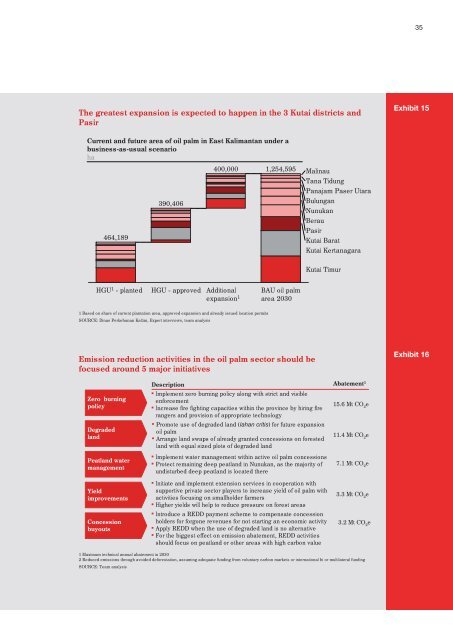East Kalimantan Environmentally Sustainable Development Strategy
East Kalimantan Environmentally Sustainable Development Strategy
East Kalimantan Environmentally Sustainable Development Strategy
You also want an ePaper? Increase the reach of your titles
YUMPU automatically turns print PDFs into web optimized ePapers that Google loves.
35<br />
The greatest expansion is expected to happen in the 3 Kutai districts and<br />
Pasir<br />
Current and future area of oil palm in <strong>East</strong> <strong>Kalimantan</strong> under a<br />
business-as-usual scenario<br />
ha<br />
400,000 1,254,595<br />
464,189<br />
HGU 1 - planted<br />
390,406<br />
HGU - approved<br />
SOURCE: Dinas Perkebunan Kaltim, Expert interviews, team analysis<br />
Additional<br />
expansion 1<br />
1 Based on share of current plantation area, approved expansion and already issued location permits<br />
BAU oil palm<br />
area 2030<br />
Emission reduction activities in the oil palm sector should be<br />
focused around 5 major initiatives<br />
Zero burning<br />
policy<br />
Degraded<br />
land<br />
Peatland water<br />
management<br />
Yield<br />
improvements<br />
Concession<br />
buyouts<br />
Malinau<br />
Tana Tidung<br />
Panajam Paser Utara<br />
Bulungan<br />
Nunukan<br />
Berau<br />
Pasir<br />
Kutai Barat<br />
Kutai Kertanagara<br />
Kutai Timur<br />
Description Abatement 1<br />
▪ Implement zero burning policy along with strict and visible<br />
enforcement<br />
15.6 Mt CO<br />
▪ Increase fire fighting capacities within the province by hiring fire<br />
2<br />
e<br />
rangers and provision of appropriate technology<br />
▪ Promote use of degraded land (lahan critis) for future expansion<br />
oil palm<br />
11.4 Mt CO<br />
▪ Arrange land swaps of already granted concessions on forested<br />
2<br />
e<br />
land with equal sized plots of degraded land<br />
▪ Implement water management within active oil palm concessions<br />
▪ Protect remaining deep peatland in Nunukan, as the majority of 7.1 Mt CO 2<br />
e<br />
undisturbed deep peatland is located there<br />
▪ Initiate and implement extension services in cooperation with<br />
supportive private sector players to increase yield of oil palm with<br />
3.3 Mt CO<br />
activities focusing on smallholder farmers<br />
2<br />
e<br />
▪ Higher yields will help to reduce pressure on forest areas<br />
DRAFT<br />
▪ Introduce a REDD payment scheme to compensate concession<br />
holders for forgone revenues for not starting an economic activity<br />
▪ Apply REDD when the use of degraded land is no alternative<br />
▪ For the biggest effect on emission abatement, REDD activities<br />
should focus on peatland or other areas with high carbon value<br />
3.2 Mt CO 2<br />
e<br />
Exhibit 15<br />
Exhibit 16<br />
1 Maximum technical annual abatement in 2030<br />
2 Reduced emissions through avoided deforestation, assuming adequate funding from voluntary carbon markets or international bi or multilateral funding<br />
SOURCE: Team analysis

















